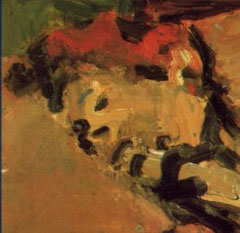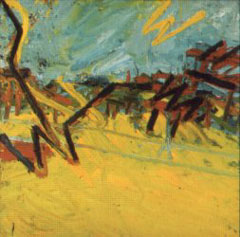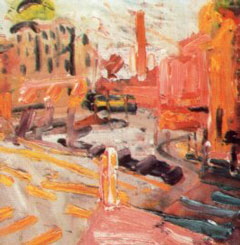Private view
By John Hendry
Of the many genres that emerged during the first half of the twentieth century, expressionism was one of the most significant. Its essence was that painting expressed something from within, rather than recorded an impression of an external view.
 |
||
Julia Sleeping, 1978 |
||
It was part of a general movement in the arts from the public to the private, from the objective to the subjective.
With expressionism, the things being painted became less important than the way it was painted; the strident colours and brushwork were the mechanisms for conveying the real subject matter - the artist's state of mind. This reached its logical conclusion with abstract expressionism after the Second World War in the USA. Why have a subject at all?
In Britain, Auerbach, Leon Kossoff and others kept their expressionism figurative. In Auerbach's case, only just. Recognisable forms emerge uncertainly from the dense clods of thick paint, but whatever is depicted - a sedentary nude, a reclining head, a seated figure - is not really important. The subject matter is inevitably the artist and his paints.
This is the private world set before us in the Royal Academy's Auerbach retrospective, showing over 100 paintings, drawings and sketches from the beginning of his career in 1954 to the present.
 |
||
Primrose Hill, Autumn Morning, 1968 |
||
A set of four views of Primrose Hill, London, takes up almost a whole wall. An autumn scene from 1968 is positively jaunty with its blue sky and yellow zigzags; another autumn scene suggests violent winds as intense claret brushstrokes break almost horizontally across the trees; a third is more peaceful, with gentle zigzags for foliage, this time from 1984.
All these are suggestive of parks, with trees, grass and shrubs implied by the brushwork. But the fourth picture presents something totally unrecognisable. Painted in the early sixties, it is more like a view over no-man's land in the First World War. The park, only minimally relevant to the other three paintings, is completely irrelevant to the fourth in figurative terms. Its only role has been as the setting for Auerbach to apply paint to the surface of the board or canvas.
The same rule applies to the many different portraits and pictures of seated or reclining figures. They are hollow men. Auerbach's view of humanity is grisly; often, paint is applied in thick long extended coils like viscera. The same few friends are depicted over the years, but there is no attempt to capture either their character or appearance. Faces are, to all intents and purposes, anonymous: masks of dehumanised soullessness. For the most part, they decompose in the shadows, or occasionally they float with skeletal pallor.
Even where colour is used, it is for abstract rather than figurative effect. In Head of EOW (1963-4) or EOW reclining on her blue Eiderdown, the bright streaks create a different, startling, visual impression indicative of a happier mood, but it doesn't give you any idea as to what the individual is like. A later picture, Portrait of Julia (1992), is executed in a warm red, but communicates little.
There is a static, lifeless quality to all Auerbach's internal scenes, whether or not they include human presence. Only in external views is there any suggestion of dynamism - but it remains steadfastly non-human. The wind may blow, buildings present themselves with sudden dramatic perspective, but the people barely register their presence at all. Even in the work EOW, SAE and JJW in the Garden II, painted in 1964, the people who occupy the centre ground are insubstantial figures dissolving in the summer colours.
Or, in a markedly harsher work, look at the two figures in Euston Steps (painted in 1981). At a location you'd be glamorising if you called it mundane, these frozen robots pass by with skull-like faces, each with one eye gouged out, like the Terminator.
 |
||
The Camden Theatre, Cold Spring, 1977 |
||
In truth, there are some deeply unlovely pictures on display here. A man who grew up in Nazi Germany is entitled to a very different view of humanity from those of us who grew up in a peacetime democracy. But in colour, in form and in texture, it's difficult to find any point on the emotional spectrum where you can empathise with the artist or the subject; the viewer is shut out.
Privacy in art is no bad thing. The artist is left to focus his technical skills, his emotions and his intellect without being asked to perform for the amusement of others. In the world of music, at the same time as Auerbach was establishing himself, Miles Davis was turning his back on his audience, unveiling fragile explorations of loneliness; Glenn Gould quit the concert stage irrevocably, to flourish behind the soundproof doors of the recording studio.
However, you can eavesdrop on musicians, either in the concert hall or through a recording. There's no visual equivalent, and the closed, private world of Auerbach - his studio, his sitters, his small selection of North London views - is opaque. The dried paint and pigment are too many layers removed from the emotional forge where the paintings were created.
It's like turning up on the morning after a party. The state of what you see suggests that something wonderful must have happened, but the results don't look so good.
Frank Auerbach: Paintings and Drawings 1954 - 2001
Royal Academy, Piccadilly, London
Till 12th December, 2001
Entrance £6.00
www.royalacademy.org.uk